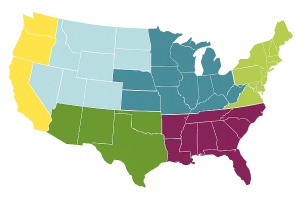All About Texas Bluebonnet
Posted By American Meadows Content Team on Jan 2, 2017 · Revised on Oct 14, 2025

Knowing your location helps us recommend plants that will thrive in your climate, based on your Growing Zone.
Posted By American Meadows Content Team on Jan 2, 2017 · Revised on Oct 14, 2025

A wildflower that has inspired naturalists, artists, hikers, and gardeners for centuries, Texas Bluebonnet is a flower steeped in legend and lore. Indeed, the first time I became aware of Texas bluebonnets was through the haunting song, Gulf Coast Highway, by Texan folk singer Nanci Griffith. Griffith sang of a hard-working couple living for many decades in a little house on the side of the road, and whose bond with the land was rooted in the glory of a bluebonnet spring. “This is the only place on earth bluebonnets grow,” sang Griffith, “and once a year they come and go, at this old house here by the road.”
Griffith painted a picture I wanted to experience for myself; and I did, many years later on a trip through the state in the spring. I wasn’t disappointed, and was lucky enough to see them spiked with the orange-red flowers of another Texan favorite, Indian Paintbrush. Lupinus texensis is one of five bluebonnet species to hold the title of the “official” state flower of Texas, and with the exception of one of the more northern species, they are annual plants, completing their life cycles in one year.
These days, and thanks to the commercial harvesting of bluebonnet seeds, this glorious wildflower is grown all over the United States by gardeners and naturalists alike. Understanding the life cycle and needs of the plant will make a huge difference in your quest to create your very own bluebonnet spring.
Texas Bluebonnet's hard seed coat makes it a great candidate for fall planting. Cooler weather and exposure to a few months of precipitation will help to naturally break down the outer casing of the seed, allowing water access to the life force inside. This will lead to perfectly-timed spring germination.
If fall planting doesn't fit your schedule, no problem! You can mimic a lengthy winter by soaking the seeds before planting in spring. Small-space gardeners can also 'scarify' the seeds by placing them between two pieces of rough sandpaper and rubbing them together or by nicking them with a nail file or clippers. Once you have done this, it is important to plant them right away.
To learn more, see our guide: How To Grow Texas Bluebonnets

If you’re having problems with growing bluebonnets, here are a few tips to help troubleshoot:
About the Author: Marianne Willburn is a columnist, blogger, and author of the new book "Big Dreams, Small Garden: Creating Something Extraordinary in Your Ordinary Space." Originally from California, she now gardens in Virginia – read more at www.smalltowngardener.com.